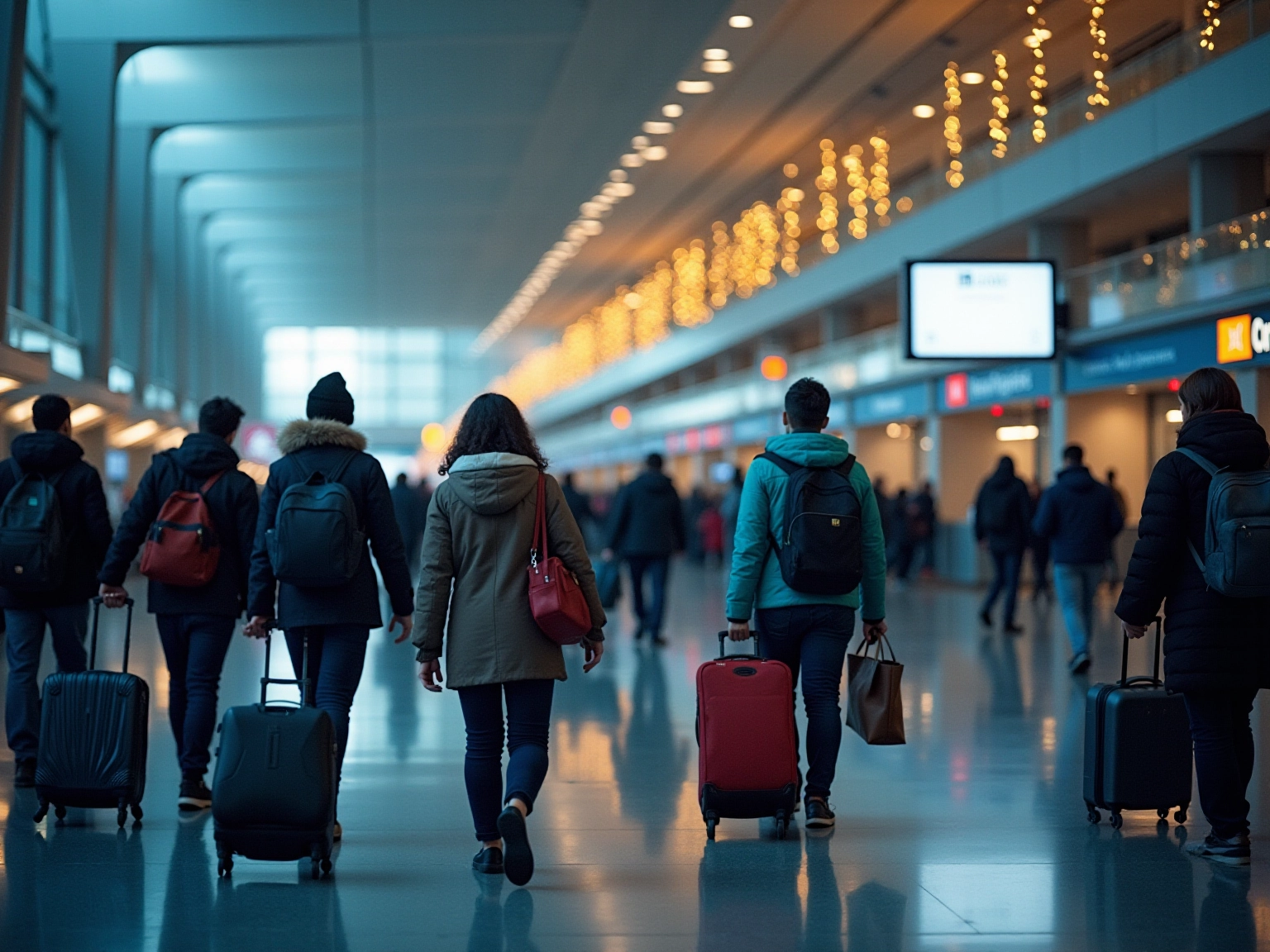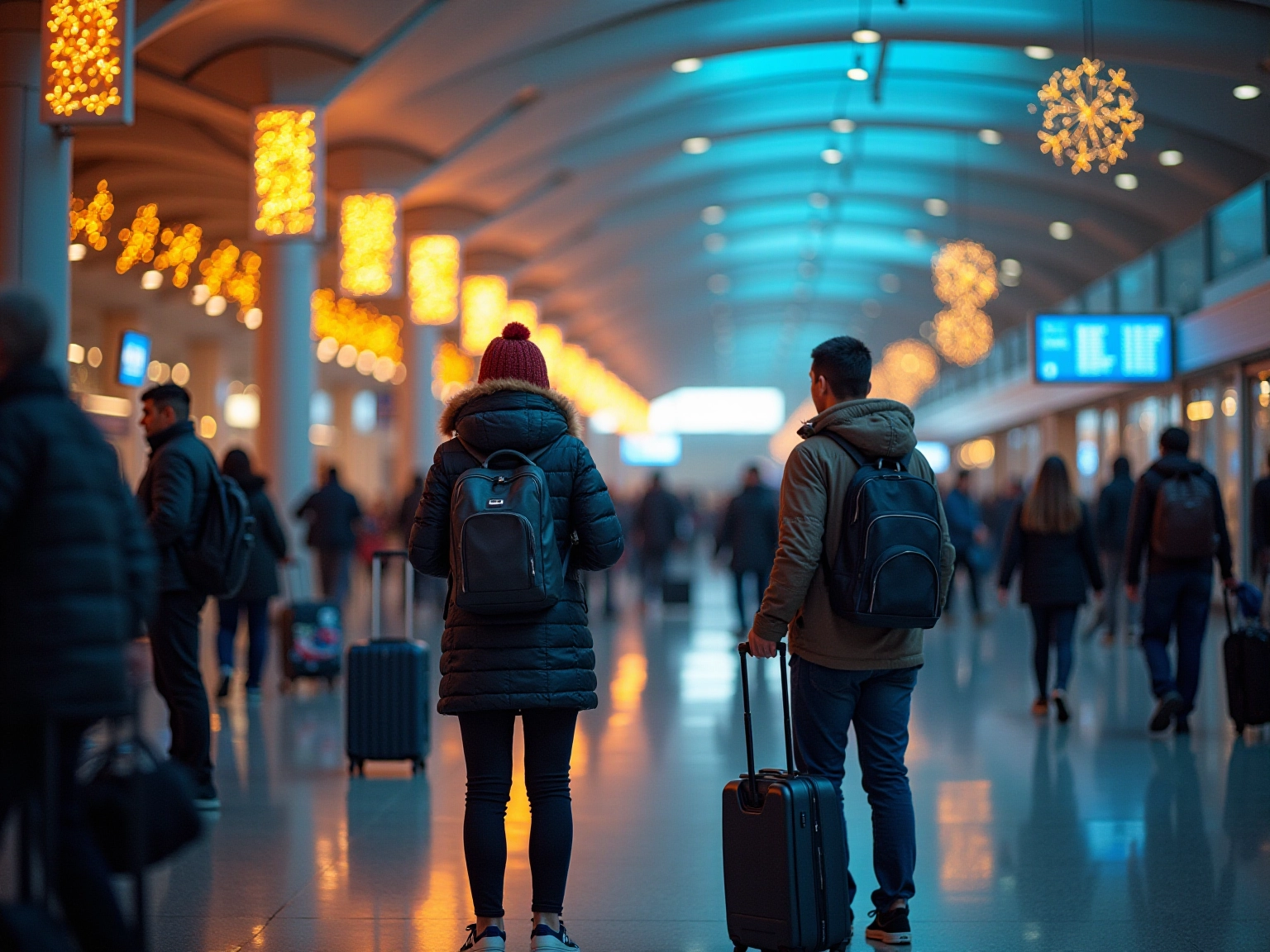Overview
The busiest days to fly during the holiday season are typically the Friday before Thanksgiving and the Sunday after! You can also expect significant air traffic on December 20th and 21st, right before Christmas. Isn’t it fascinating how travel patterns shift during this time? The article highlights this by sharing data on passenger surges around major holidays, noting a projected 20% increase in travel during peak periods. This really emphasizes the importance of strategic planning to avoid congestion and those sky-high prices. So, as you think about your holiday travels, keep these dates in mind and plan ahead for a smoother journey!
Key Highlights:
- Passenger numbers surge during major holidays like Thanksgiving, Christmas, and Memorial Day, with a projected 20% increase in 2025 compared to non-holiday periods.
- Nearly 60% of Americans plan trips around significant celebrations, emphasizing the connection between family gatherings and travel decisions.
- The busiest travel days include the Friday before Thanksgiving and the Sunday after, with significant air traffic expected on December 20th and 21st leading up to Christmas.
- Booking flights at least 30 days in advance can save travelers approximately 12% on fares compared to last-minute bookings.
- Flight prices can increase by up to 30% during peak holiday travel days, making flexibility with travel dates essential for savings.
- Travelers are advised to arrive early at airports, utilize mobile boarding passes, and consider off-peak flight times to reduce stress.
- Alternative transportation methods like trains and buses can offer less crowded and more enjoyable travel experiences during busy seasons.
- Choosing less popular travel dates or destinations can lead to more authentic and enriching experiences.
Introduction
Amid the hustle and bustle of the holiday season, travel patterns shift dramatically, creating a unique set of challenges and opportunities for you as you plan your journeys. With passenger volumes surging during significant holidays like Thanksgiving and Christmas, understanding these dynamics becomes essential for a stress-free experience!
From pinpointing the busiest days to fly to discovering the best strategies for early booking, and navigating crowded airports, this article dives into the intricacies of holiday travel. By examining trends, expert insights, and practical tips, you can better prepare for the complexities of holiday travel, ensuring that your journeys are not only manageable but also enriched by cultural experiences along the way!
Understanding Holiday Travel Patterns
Seasonal journey patterns reveal exciting increases in passenger numbers during key times, especially around cherished celebrations like Thanksgiving, Christmas, and Memorial Day. These surges are influenced by a mix of factors, including family reunions, vacation plans, and cultural customs that encourage movement. For example, the days right before and after these celebrations often see the busiest travel as families and friends come together, leading to crowded airports and higher flight costs.
Statistics suggest that during the 2025 holiday season, we can expect passenger volumes to rise by about 20% compared to non-holiday times. This highlights the importance of understanding these movement trends! Audrey Hendley, President of American Express Travel, notes, “The report indicates that individuals feel passionately about their vacations,” which emphasizes the emotional ties that influence our journey choices. This emotional aspect resonates deeply with Karen LeBlanc’s insights, who reminds us that every journey is enriched by the stories of culture and design that unfold through authentic experiences.
Additionally, a recent study showed that nearly 60% of Americans plan their trips around significant celebrations. This further underscores the strong connection between family gatherings and travel decisions. Real-world examples illustrate how families strategically plan their trips to navigate these busy periods. Many opt to travel on less congested days, like the Tuesday before Thanksgiving or the Saturday after Christmas, to avoid the heaviest travel days.
This proactive strategy not only enhances their travel experience but also helps reduce the stress associated with vacation trips.
Moreover, creative options like TCS World Travel’s private jet expeditions around the globe allow individuals to optimize their time and resources without the hassle of organizing, catering to those hectic vacation times. Understanding these patterns is essential for anyone looking to successfully navigate the complexities of holiday journeys. By recognizing the impact of family dynamics and cultural practices on travel behavior, you can make informed choices that elevate your overall experience.
The connection between journeys and cultural encounters, as shown in music tourism trends, illustrates how these elements influence trip choices. It’s crucial for explorers to stay informed and adaptable. Ultimately, embracing a creative perspective on exploration can transform how we experience and appreciate the world around us.
Identifying the Busiest Days to Fly
Understanding the busiest days to fly is essential for anyone planning a journey, especially during the festive season! Did you know that the Friday before Thanksgiving is consistently one of the busiest days of the year? Millions of passengers navigate airports on this day, making it quite the adventure. And let’s not forget the Sunday after Thanksgiving, when families are heading back home after all the celebrations.
In 2025, the TSA reported that on January 1 alone, over 2.3 million passengers traveled through checkpoints! This number really highlights the ongoing demand for air travel during peak periods.
As the festive season approaches, the days leading up to Christmas, particularly December 20th and 21st, see a significant rise in air traffic. These dates are bustling with travelers eager to reach their holiday destinations, resulting in crowded airports and longer wait times. For instance, in 2024, the Jeju Airport (CJU) to Seoul Gimpo (GMP) route was the most active flight path, boasting 1.2 million scheduled seats in August. Talk about high demand!
Real-life experiences from travelers during these peak days often reflect the challenges of navigating busy airports. Many share stories of long lines at security checkpoints and packed flights. So, if you’re planning to travel during these times, it’s crucial to prepare accordingly. As Hopper wisely advises, “If you plan to wait until January, avoid the 2nd like the plague!” Previous years have shown a notable spike in screenings on that day.
Airlines are also responding to this heightened demand. Cathay Pacific and HK Express have announced frequency increases across 20 routes to mainland China, showcasing how airlines adapt to busy travel patterns. Plus, advancements in transportation, like the collaboration between Ethiopian Airlines and Archer Aviation to create eVTOL journeys, highlight the evolving landscape of air travel. This is particularly exciting for design lovers who appreciate the blend of contemporary architecture and technology in travel interactions.
Experts suggest that steering clear of travel on peak days can lead to a more enjoyable trip. After all, congestion can significantly impact your overall journey. By recognizing these patterns, you can make informed choices that enhance your vacation plans, allowing you to focus on the cultural experiences and design elements that truly enrich your travels.
Best and Worst Days for Holiday Travel
When you’re planning your vacation travel, it’s super important to understand the busiest days to fly! Believe it or not, flying on Christmas Day or New Year’s Day can be a fantastic choice. These dates usually see fewer travelers, making for a more relaxed journey. On the flip side, the days leading up to these celebrations, especially December 22nd and 23rd, are notorious for being the busiest, with so many eager travelers trying to reach their destinations.
Phil Dengler, co-founder and head of editorial and marketing at The Vacationer, points out that December 23 is generally considered the worst day to fly for Christmas—but hey, that’s not set in stone! And don’t forget about the Sunday after New Year’s; it’s one of the busiest days as folks head back home after the festivities.
Did you know that 59% of people choose to stay with family during the holidays? Meanwhile, 26% opt for hotels or resorts, 7% stay with friends, and 6% prefer rentals. This influx of visitors definitely contributes to crowded airports and busy flight schedules. To make it through this hectic time, experts suggest packing a little patience and being ready for potential delays. Bestselling author Alex Caspero emphasizes the importance of planning for unexpected hiccups that might pop up.
A case study titled ‘The Importance of Patience During Festive Journeys’ really drives this point home, showing how being prepared can help ease stress during those busy travel times.
By picking your travel dates wisely and considering off-peak options, you can really enhance your holiday experience! Avoiding the chaos of peak days not only reduces stress but also makes for a more enjoyable journey, aligning perfectly with your desire for authentic and meaningful experiences.

The Importance of Early Flight Booking
Reserving flights in advance is crucial—especially during those busy holiday periods when everyone’s trying to travel! You might notice that as your departure date approaches, airlines often raise their prices, particularly on peak days. This can lead to higher costs for those who wait until the last minute. Research shows that securing domestic flights at least 30 days ahead can lead to substantial savings, with average fares being about 12% lower than the peak prices we see on Sundays.
As a little ‘Nerdy Tip,’ this trend really highlights the financial perks of booking early! Plus, planning ahead not only helps you save money but also opens up a wider range of flight options and seating arrangements. For example, a case study by Keyes points out that midweek flights—especially on Tuesdays and Wednesdays—are often more budget-friendly than those on Mondays and Fridays, which are typically the busiest days due to business travel. And here’s a bonus: early morning flights often have better on-time arrival rates, making your journey even smoother!
Economists recommend reserving flights one to three months in advance to dodge those pesky price increases, as fares during this window average about 25% lower than last-minute offers. Just a heads up, though: if you cancel a flight to rebook at a lower price, you might receive a voucher or credit instead of a refund, which could impact your plans. This strategic approach to flight reservations not only eases the stress of last-minute planning but also allows you to enjoy a more relaxed journey, knowing you’ve snagged the best rates and options.
And for all you design enthusiasts out there, early booking can elevate your travels by ensuring access to unique design-focused destinations and events—making every experience that much more enriching!
How Holiday Travel Affects Flight Prices
Flight prices can really take a turn during the holiday season, especially on those busiest travel days when demand skyrockets! As major holidays roll around, airlines tend to tweak their pricing strategies, fully aware that these days see a surge in passenger volumes. Just think about it: during peak travel times like Thanksgiving and Christmas, airfare can jump by as much as 30% compared to quieter periods.
This trend isn’t just a rumor; it’s a reflection of the broader market dynamics where demand and pricing are closely linked.
So, how can you navigate these price hikes? Flexibility with your travel dates is key! By steering clear of the busiest days, you can save a significant amount. Plus, exploring alternative airports might lead you to more budget-friendly options.
Another savvy move is to use fare comparison tools. These handy resources help you spot the best deals, ensuring you can plan your trips without breaking the bank. In fact, many travelers report saving an average of $687 on trips in 2024 by taking advantage of reward programs—what a fantastic way to cut costs during the festive rush!
Recent insights from travel experts reveal that the international airfare landscape is changing. While it might be a bit trickier to find bargains this year, there are still affordable flight options to destinations in Asia, like Japan and South Korea, thanks to increased capacity in those areas. This situation shows just how competitive global pricing can be, meaning savvy travelers can still benefit from lower fares, especially during the holiday season.
The case study titled ‘Bargains for Asia Flights’ highlights that, despite some challenges, there are affordable choices out there for those who stay informed and proactive.
As Paul Jacobs, Senior Vice President for North America at Kayak, says, “We’re seeing increased competition in international markets, which could be why we are seeing a decrease in prices for international flights.” This competitive vibe underscores the importance of being aware of pricing trends and taking action to snag the best deals during those busy holiday travel days. And with the Citi Premier® Card no longer available, it might be time to explore different rewards options to maximize your savings.
For those of you who appreciate design, your travels can be even more enriching by diving into local artistry and cultural stories. This transforms your vacation into a chance to connect deeply with the creative spirit of each destination. Karen LeBlanc, a host and author for The Design Tourist, emphasizes that every location has a unique story to tell through its local art, architecture, culture, and craft, encouraging you to engage in the genuine experiences waiting for you.

Tips for Navigating Busy Airports
Navigating busy airports during the holiday season can feel a bit daunting, can’t it? But don’t worry—implementing some effective strategies can really ease the experience! One of the most important tips I can share is to arrive at the airport early. This gives you plenty of time for check-in, security screening, and any unexpected delays that might pop up.
For example, on January 1, 2025, a whopping 2,313,111 passengers traveled through TSA checkpoints. That’s a lot of people! It really highlights the potential for long lines and wait times during peak travel days.
Utilizing mobile boarding passes can also streamline your check-in process, which means less time spent at kiosks. And here’s another valuable strategy: familiarize yourself with the airport layout! Knowing where to find security checkpoints, gates, and amenities can save you precious time and help alleviate stress.
If you can, consider scheduling your flights during off-peak hours, like early morning or late evening. This way, you can dodge the heaviest crowds. Plus, programs like TSA PreCheck and Global Entry can speed up security screenings and customs procedures, giving you considerable time savings if you travel regularly.
Just a heads up—both TSA PreCheck and Global Entry require an application process that might take a few weeks for approval. But trust me, the investment—$85 for TSA PreCheck or $120 for Global Entry—can greatly enhance your airport experience.
To further minimize stress during the holidays, I recommend packing essential items like medications, important documents, electronics, and a change of clothes in your carry-on bag. This way, you’ll be prepared for any delays or unforeseen circumstances.
By adopting these strategies, especially during the busiest days to fly, you can navigate crowded airports more effectively. Let’s transform those potentially stressful situations into smoother journeys together!
Alternative Travel Strategies for Busy Seasons
Navigating the hectic environment of peak holiday journeys can be a breeze with a few effective strategies inspired by Karen LeBlanc from The Design Tourist. One of the best tips? Schedule your trips on days that aren’t the busiest to fly, like the Tuesday or Wednesday before Thanksgiving or Christmas. These days often see a noticeable dip in passenger numbers, making for a more leisurely journey experience.
And here’s something to keep in mind: U.S. Travel is predicting a 4.0% increase in business spending for 2025! That means the demand for journeys during peak seasons is on the rise, so planning wisely is more important than ever.
Timing isn’t the only factor to consider. Have you thought about alternative modes of transportation? Trains and buses can offer a scenic and less stressful option compared to crowded airports. Many travelers have found joy in taking train services during festive periods, enjoying the comfort and convenience while avoiding the chaos of air travel.
As James Adkin, Asia Program Manager, points out, “It’s evident that there’s significant interest in Central Asia and the Silk Road currently.” This suggests that exploring less-visited locations can lead to unique experiences.
Choosing destinations that are off the beaten path during the holiday season can also lead to a more genuine and enjoyable encounter. By opting for less crowded spots, you can truly immerse yourself in local culture. Karen LeBlanc emphasizes the importance of engaging with local art and architecture, which can deepen your understanding of a place’s story.
Looking ahead, trends for 2024 show a sustained interest in adventure journeys. This hints at a strong market for experiential travel, reinforcing the idea of seeking out those less popular destinations.
Flexibility with your travel dates is another key strategy. Just shifting your departure and return dates by a few days can lead to significant savings and a more pleasant journey. For instance, flying a day earlier or later than the busiest days can help you cut costs and enhance your overall experience.
Interestingly, about 25% of global travelers still prefer to communicate with a booking agent for their reservations. This could be a great option if you’re looking for assistance in organizing your holiday trips.
As the travel landscape evolves, understanding these alternative strategies will empower you to make informed choices, ensuring your holiday experiences are both enjoyable and memorable. With over 40 years of experience, Explore offers expert-led small group tours that focus on cultural immersion and community mindfulness, providing valuable options for guided travel during busy seasons.
Conclusion
Holiday travel can be a mixed bag of challenges and opportunities, but it’s all about how you approach it! Understanding travel patterns—like the busiest days to fly and the perks of booking early—can really elevate your experience. For instance, knowing that the Friday before Thanksgiving or the Sunday after Christmas are peak travel days can help you plan smartly and dodge the crowds, making your journey much smoother.
Don’t forget about the financial side of things! Booking your flights early not only locks in lower fares but also opens up a world of options, which is crucial for those of us watching our budgets. With airfare prices skyrocketing during peak times, being flexible with your travel dates and using fare comparison tools can really help keep costs down and ensure you’re enjoying your trip even more.
Navigating busy airports? It’s all about being proactive! Arriving early and using tech like mobile boarding passes can make a world of difference. Plus, considering alternative travel options—like trains or off-peak flights—can turn those potentially hectic travel days into manageable and enriching experiences.
Ultimately, the holiday season is a beautiful time for connection and cultural exploration. By embracing these insights and strategies, you can not only navigate the ins and outs of holiday travel with ease but also dive into the authentic experiences each destination has to offer. This mindset doesn’t just enhance your journey; it deepens your appreciation for the cultural stories that unfold through travel!
Frequently Asked Questions
What are the key times when passenger numbers increase significantly?
Passenger numbers see exciting increases during key celebrations like Thanksgiving, Christmas, and Memorial Day, influenced by family reunions, vacation plans, and cultural customs.
How much can we expect passenger volumes to rise during the 2025 holiday season?
During the 2025 holiday season, passenger volumes are expected to rise by about 20% compared to non-holiday times.
What emotional factors influence travel decisions during holidays?
Many individuals feel passionately about their vacations, and emotional ties to family gatherings and cultural customs significantly influence journey choices.
What percentage of Americans plan their trips around significant celebrations?
Nearly 60% of Americans plan their trips around significant celebrations, highlighting the connection between family gatherings and travel decisions.
What strategies do families use to navigate busy travel periods?
Families often opt to travel on less congested days, such as the Tuesday before Thanksgiving or the Saturday after Christmas, to avoid the heaviest travel days.
How can creative travel options enhance the holiday experience?
Options like private jet expeditions can help individuals optimize their time and resources during hectic vacation times without the hassle of organizing.
What are some of the busiest travel days during the festive season?
The Friday before Thanksgiving and the Sunday after Thanksgiving are consistently among the busiest travel days of the year, with significant passenger volumes.
What notable travel statistics were reported for January 1, 2025?
On January 1, 2025, over 2.3 million passengers traveled through TSA checkpoints, indicating high demand for air travel during peak periods.
Which days leading up to Christmas see a rise in air traffic?
December 20th and 21st see a significant rise in air traffic as travelers head to their holiday destinations, resulting in crowded airports and longer wait times.
How are airlines responding to increased travel demand during peak periods?
Airlines like Cathay Pacific and HK Express are increasing flight frequencies across multiple routes to accommodate the heightened demand during busy travel times.


































